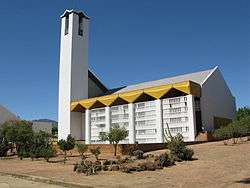Eendekuil
| Eendekuil | |
|---|---|
|
Eendekuil Church | |
 Eendekuil
| |
| Coordinates: 32°41′S 18°53′E / 32.683°S 18.883°ECoordinates: 32°41′S 18°53′E / 32.683°S 18.883°E | |
| Country | South Africa |
| Province | Western Cape |
| District | West Coast |
| Municipality | Bergrivier |
| Area[1] | |
| • Total | 0.85 km2 (0.33 sq mi) |
| Population (2011)[1] | |
| • Total | 1,530 |
| • Density | 1,800/km2 (4,700/sq mi) |
| Racial makeup (2011)[1] | |
| • Black African | 2.2% |
| • Coloured | 89.3% |
| • Indian/Asian | 1.1% |
| • White | 6.5% |
| • Other | 0.9% |
| First languages (2011)[1] | |
| • Afrikaans | 96.9% |
| • Other | 3.1% |
| PO box | 7335 |
| Area code | 022 |
Eendekuil is a settlement in West Coast District Municipality in the Western Cape province of South Africa.
Situated 30 km north of Piketberg, the village was the terminus of the Cape Town railway until the end of the Anglo-Boer War, and it remains the railhead for the Citrusdal region, which lies on the other side of the Olifants River.[2]
References
| |||||||||||||||||||||||||||||
This article is issued from Wikipedia - version of the Sunday, July 27, 2014. The text is available under the Creative Commons Attribution/Share Alike but additional terms may apply for the media files.

.svg.png)